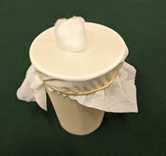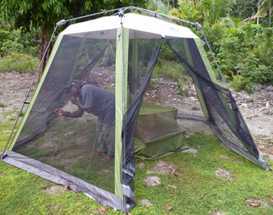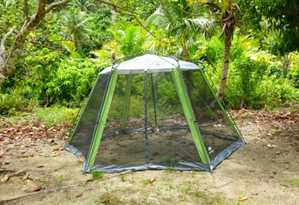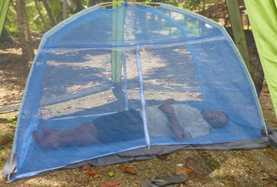Standard Operating Procedure for human baited tent traps to sample host-seeking mosquitoes
Tanya L L Russell, Kyran Staunton, Thomas R Burkot
Disclaimer
This Standard Operating Procedure may be used for training and reference purposes. Users are responsible for ensuring any edits to this document are produced and approved in accordance with all relevant legal and ethical requirements governing the surveillance operation.
Abstract
The purpose of this SOP is to outline the materials and processes required to deploy human baited traps to collect host-seeking adult mosquitoes.
Description: The principal behind human baited tent traps is to utilise one person as a bait to attract mosquitoes, which are then trapped by the tent structure. There are two components: the net to protect the human bait from mosquito bites, and the outer tent that retains the mosquitoes. The traps are termed both tent traps or double net traps.
Target species and physiological states: Captures host-seeking females of many species.
Entomological surveillance indicators: Adult vector occurrence and density as well as adult vector behaviour (human biting rate, biting time).
Advantage: This method uses cheap materials and can be easily constructed.
Disadvantage: This method is labour intensive, requiring two staff per tent, one to act as the bait while the second collects mosquitoes at regular intervals.
Sampling period: The human baited tent traps are often deployed overnight for 12 h periods.
Data: Total number of host-seeking females per sampling effort (by species). When necessary, field data is merged with the results of subsequent laboratory analyses.
Before start
Human ethics
Where human ethics approval is required and granted, village residents will be recruited following standard informed consent procedures. The potential risks and benefits of mosquito sampling will be discussed verbally in the local language with the aid of a participant information sheet detailing these issues in writing.
Attachments
Steps
Sampling procedure
Ensure collectors have equipment required for collecting mosquitoes.
At the start of the night, set up sufficient paper cups for the work. Generally, each collector will have 12 paper cups per night in total if collections occur hourly from 18.00 to 06.00. Ensure that the cups are used in the correct order for time.


To collect mosquitoes visually search inside the outer structure and catch any trapped mosquitoes with an oral aspirator.
Resting mosquitoes are generally passive and can be collected with careful visual inspections and an oral aspirator. Place mosquitoes directly into the labelled collection cups.
Start searches at a designated point in the tent and carefully walk around the entire structure back to the starting point, this should take about 10 – 20 minutes.
After entering the structure, the openings can be closed to prevent mosquitoes escaping (i.e. doors closed or edges lowered to the ground).

Temporarily store the mosquitoes in labelled collection cups until processing and long-term storage.
For details on processing and storage see Tanya Russell, Kyran Staunton, Amanda Murphy, Thomas Burkot 2022. Standard operating procedures for mosquito vector surveillance, processing and storage. protocols.io https://dx.doi.org/10.17504/protocols.io.eq2lyn13qvx9/v3
Additional notes
Mosquito collections for anopheline will be recorded for each hour between sunset and dawn but the hours of collection may be changed based on knowledge of the biting behaviours.Generally, it is good that collections start before the time of earliest biting and end after host seeking has stopped.Sometimes, partial night collections may be sufficient to monitor mosquito densities, particularly if most host biting occurs during only part of the night for anophelines.
Individuals collecting mosquitoes from the outer structure need to avoid acting as a lure that attracts mosquitoes to the barrier screen. This risk can be minimized by the collectors wearing repellent, and the collectors moving at least 10 m away from the human-baited tent in between collection periods.
Do not collect more than five mosquitoes in one sucking tube before transferring them to the paper cup.
The catches for each hourly interval should be stored in separate collection cups labeled with date, location and hour of collection.
Head torches are very useful as they provide a hands-free solution. People have used red lens (~680 nm) which is considered invisible to mosquitoes and therefore does not impact behavior.




